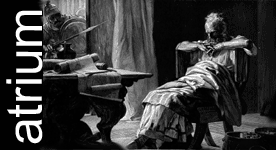No sooner said than done (see previous post below) ... the incipit of a piece from the Gloucester County Times:
... more
Italian authorities, investigating a global antiquities smuggling ring, reportedly have tracked plundered treasure to the Princeton University Art Museum and seven other major American museums.
The Princeton connection to a smuggling probe that has rocked the staid upper echelons of American museums centers on one or two clay vases from ancient Greece that Princeton owns.
The two vases, more than 2,300 years old, are showcased in separate one-piece displays in a public exhibit room in the Princeton museum, one of the nation's largest university art museums.
The Princeton museum begrudgingly revealed this week that Italian authorities sought information late last year on the two vases acquired by the museum in 1989.
"In December 2004, Italian authorities investigating an alleged violation of the laws of Italy requested details about the acquisition in 1989 of two ancient Greek painted ceramic vases by the Princeton University Art Museum," according to a statement from the museum in response to inquiries from The Times.
"In January 2005, the art museum provided Italian authorities with the information requested.
"Since that time, the museum has received no further communication from authorities in Italy, although they are quoted in recent press accounts as stating that they possess evidence that the two vases left Italy illegally and should be returned."
Princeton officials are adamant the museum obtained the vases legitimately and reject the allegation that either piece is a fenced antiquity.
"The museum purchased these vases in good faith and has no knowledge of any wrongdoing associated with their acquisition," Princeton art museum Director Susan M. Taylor said in a statement late Thursday.
One of the objects is a 12-inch-tall psykter, a mushroom-shaped wine-cooling vessel from approximately 510 B.C. in the Attic region of Greece, according to the museum.
The other is a 22-inch-tall Apulian red-figure loutrophoros, a type of ceremonial vase described by Oxford University as a vessel that held water for the bridal bath in weddings or was placed in the graves of unmarried women.
Princeton's loutrophoros dates back to about 330 B.C., in Italy's southeast region of Apulia, according to the museum.
Both vases are clay-red and black decorated with paintings of figures and objects.
Princeton's denials of impropriety come amid media reports published in the past two weeks that allegedly tie Princeton and other leading cultural centers - including New York's Metropolitan Museum of Art - to the Italian smuggling investigation.
The psykter is one of "many, many items" at the Princeton museum that Rome prosecutor Paolo Ferri said originated with convicted Roman antiquities trafficker Giacomo Medici, Bloomberg News reported in an Oct. 31 article.
But the psykter was the only item now at Princeton that the Bloomberg article identified as having been included in Italian court documents as an allegedly looted piece.
"Our museum has conducted a thorough search of its records and found nothing that indicates the museum has received any pieces - directly or indirectly - from Giacomo Medici," university spokeswoman Cass Cliatt stated in an e-mail Wednesday.
Michael Padgett, the museum's curator of ancient art since 1992, said he couldn't disclose from whom the museum acquired the psykter and loutrophoros because it's possible the pieces will become a matter for litigation.
At first, Padgett was adamant Wednesday that Italian authorities hadn't even contacted Princeton and that the museum initiated a review of the two vases in its approximately 60,000-item collection based only on press reports.
"To my certain knowledge, we haven't been contacted by the Italians," said Padgett, to whom museum spokeswoman Ruta Smithson had referred The Times' initial inquiries. "We're waiting for more information."
Padgett at first said he didn't know how to reconcile the apparent contradiction between his comment and the museum's repeatedly stated position that it has "cooperated with the Italian authorities by providing the information they have requested."
Later Wednesday, Padgett said he had misspoken.
"They did request information and that was provided over a year ago," he said.
His earlier denial simply meant that Princeton since last year has not heard anything further from Italian authorities, other than through press reports, Padgett said.
Taylor, who has been the museum's director since 2000, said Princeton won't fight to keep the vases if they turn out to have been obtained illegally.
"If proof of illegality is presented to the museum, the vases will be returned, as we have returned other items in the past," Taylor said.
Her comment reiterated a point Padgett made Wednesday.
Smithson said the Princeton museum, without prompting from outsiders, routinely vets items in its collection to verify that their provenance - or documented ownership history - is legitimate.
From time to time, not necessarily through any fault of the museum, an object is discovered to have been passed on by looters before reaching Princeton, Padgett said.
"It's not an unusual occurrence (either at Princeton or other museums) that something turns out to have been accidentally acquired that belongs to someone else," Padgett said.
The Princeton museum's acquisition policy is designed to avoid the need for belated discoveries of pillaged art.
"The acquisition policy of the Princeton University Art Museum requires extensive due diligence in researching all objects before adding them to its collection," museum officials said in Thursday's statement.
Taylor said the Princeton museum has a long history of cooperating with Italy in matters of disputed provenance. The Italian investigation reportedly has tracked more than 100 items looted from Italy - mostly from legally protected archaeological sites - to eight major U.S. museums and to galleries, private collections and museums in Europe and Asia.
... more
